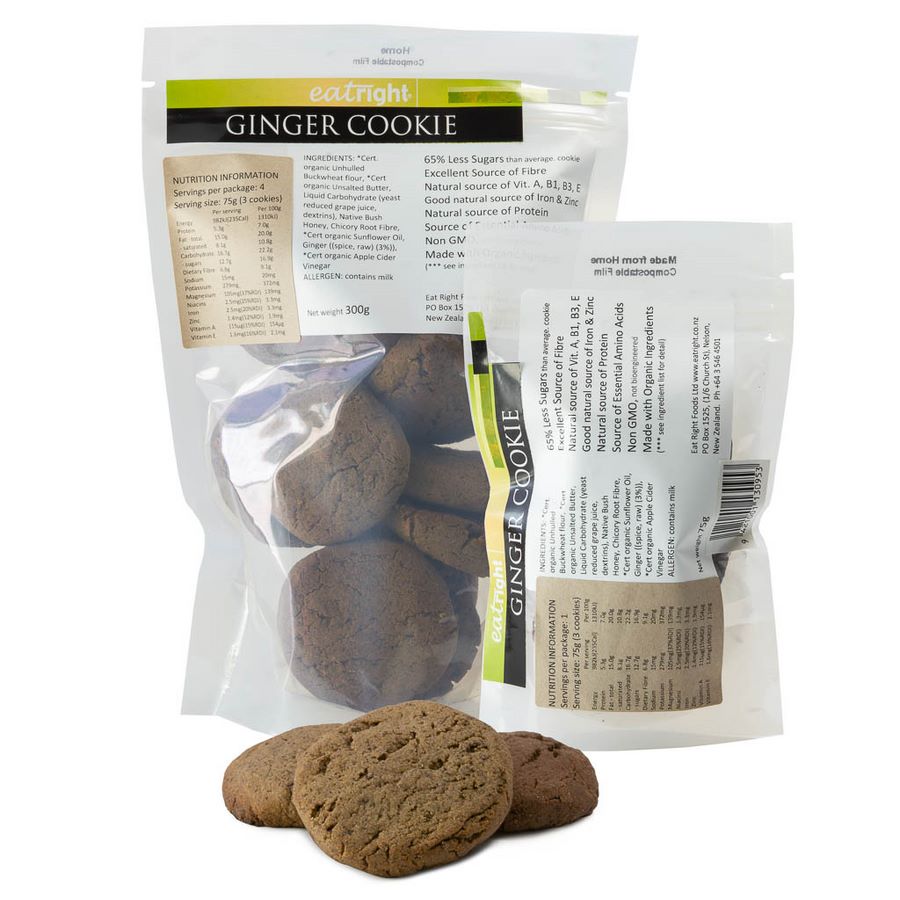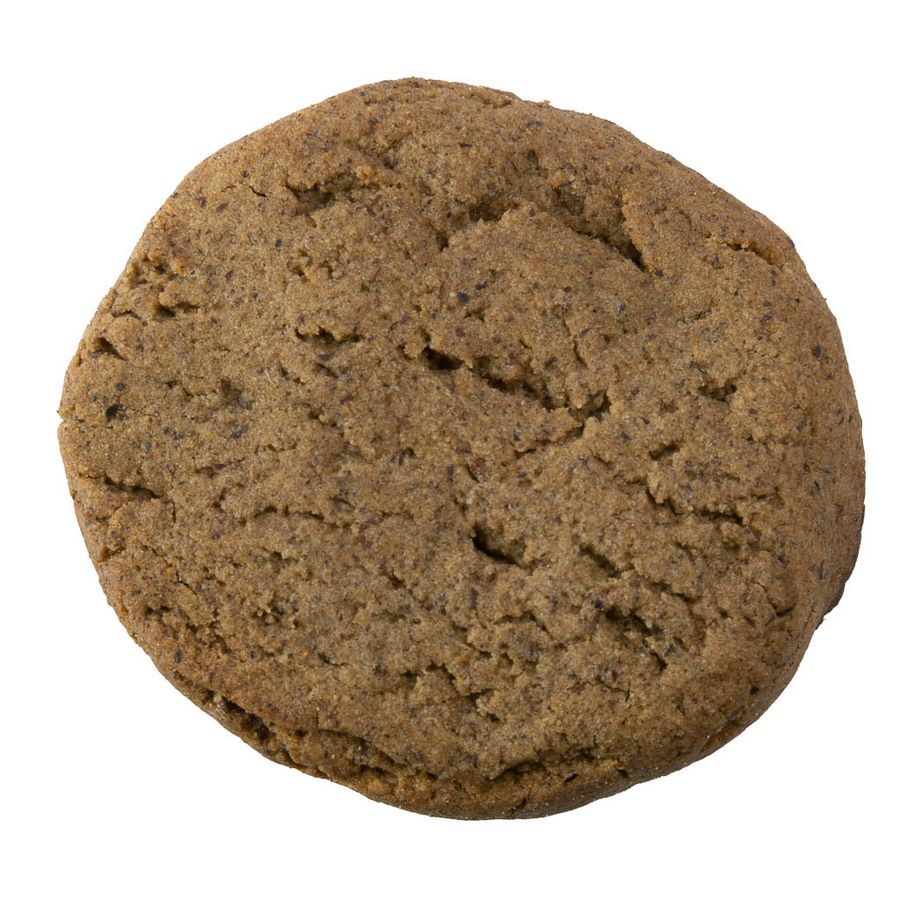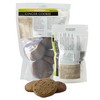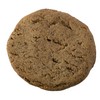Ginger *SEEd & Switchel* Cookies
A great tasting, nature inspired EATRIGHT® seed, not wheat, cookie with fibrinolytic ginger "zing" (fibrinolysis enzyme activators: curcumin, niacin), native raw bush honey (bees collecting from Kunzea ericoides, Nothofagus solandri var. solandri and fusca (endemic to the Nelson region of New Zealand), a claimable source of preformed vitamin K2 and 'not from concentrate' apple cider vinegar (a controlled ferment with 'Mother' wild-type, non-engineered bacteria).
When we updated the ingredients [^^] we included "switchel" [switchel is a vinegar drink, seasoned with ginger and sweetened with honey, of British America origin]. But, in this product, it is non diluted with 'short time' processing.
It has a solid food matrix for prophylactic digestibility (antiemetic [Gk emeo vomit] ("3"; KOM; PIP; WHO) ‘rare score of "3": clinical trials…plant itself’; with 14,396ppm from phytochemicals: 6-gingerol, camphor, gingerol and, “twice as pungent as gingerols”, shoGAOL (ref: Journal of Drug Development (vol. 6(1): 25-39; pub. 1993)), less gas and wind emissions [whistle v.i. & t.], less flatuence [L pedo break wind] on petomane scale (humans pass "400-2000ml of flatus daily" including CO2 and methane ref: British Society of Gastroenterology), regulation of energy and absorption of inherent bioactives ie essential mineral and vitamin nutrients in the product [NOT over-processed removal, then added back fortifiers or isolates].
Ingredients: *cert. organic stoneground unhulled brank grist (Fagopyrum esculentum Moench), {Kosher, Halal & Organic certified} unsalted butter (milk) [good preformed source of vitamin D (5.2mcg/100g (vitamin D3 or cholecalciferol), vitamin B12 (0.68mcg/100g cobalamin) and scarce MUFA 24:1 (0.1mg/100g)], liquid carbohydrate (yeast reduced grape juice, dextrins), unfiltered native bush honey (incl. kanuka, honeydew), {Kosher & Halal certified} kasni root fiber (Cichorium intybus L.), cold pressed *cert. organic sunflower oil (Helianthus annuus L.), ginger (*cert. organic sundried ground and unpeeled fresh/raw root shavings) (ZINGiber officinale Roscoe), *cert. organic unfiltered unpasteurised [not 'white' from cane] raw apple cider vinegar (ACV) including unique variety, season dependent, Malus pumila 'Gala' × 'Splendour' sciros. Contains: milk
Nutrition Information per 75g (2.6oz) serving size
(three 25g cookies consumed over the period of one day)
Macro Nutrition Information: Energy 982kJ (235Cal)(11%DI), Protein (5.3g)(11%DI,10%DV), Protein-gluten (0g), Fat-total (15.0g)(21%DI,19%DV), Fat-sat (8.1g)(34%DI,41%DV), CHO-total (16.7g)(5%DI,6%DV), CHO-total sugars (12.7g)(14%DI), CHO-lactose (0.1g), CHO-galactose (0.0g, traces maybe present), Dietary Fiber/Fibre (6.8g)(23%DI,24%DV), Sodium (15mg)(1%DV)
Other Potential Claims: [%DI most to least scale] Vitamin K** (149mcg)(124%ESADDI), Magnesium (105mg)(33%RDI), Niacin (2.5mg)(25%RDI), Iron (2.5mg)(20%RDI), Vitamin E (1.6mg)(16%RDI), Manganese (808mcg)(16%ESADDI), Vitamin A (115mcg)(15%RDI), Thiamin (0.2mg)(15%RDI), Zinc (1.4mg)(12%RDI), Potassium (279mg)(6%RDI), Essential Amino Acids (1645mg (including Tryptophan (75mg), Methionine (65mg)) and >50mg choline+betaine+folate collaboration
Abbreviations: The % Daily Value (%DV), % Daily Intake (%DI), Recommended or Reference Daily Intakes (%RDI), Estimated Safe and Adequate Daily Dietary Intake (%ESADDI) tells you how much a nutrient, in a serving of food, contributes to a daily diet. An average adult diet of 8,700KJ or 2,000 calories a day is used for general nutrition advice. ** Vitamin K (K1+K2(MK4-MK13)) (not on-pack/container) as it is a calculated proximate ONLY, what [they] eat matters ie has an effect on actual values.
Shelf life: 18 weeks or more depending on the storage methods used. 'Best before' labels are used rather than 'use by'
Country of Origin: Made in NEW ZEALAND. >80% grown in NEW ZEALAND ingredients with <20% imported indirectly from the USA, Fiji and/or India
Processes include: [NOT in isolation] Temp. = Moderately slow; Time = Short time
Food SAFETY Verification: Certificate Number 2699 (an International Accreditation NEW ZEALAND (IANZ) third-party inspection body audit, pursuant to the Food Act 2014) issued to Eat Right Foods Ltd at MPI's highest risk level, for the manufacture, processing, exporting, packing, holding and distribution of food products. And the independent audit company is ISO 17020 accredited
Additional Audited Compliance: Australian NEW ZEALAND Food Standards Act 1991 (FSANZ Act) and Code 2002; CAFTA Model Recall Procedure: Food Australia, 45(7), 313-316 1993; Codex Alimentarius Commission: Hazard Analysis Critical Control Point (HACCP) System & Guidelines Annex to CAC/RCP 1-1969, Revised 2022; Food Regulations 2015 (LI 2015/310), version July 2023 and Fair Trading Amendment Act 2021
Address: PO Box 1525 [Level 1, 6 Church St], Nelson 7040, NEW ZEALAND
Availability: An EATRIGHT® Online Shop Only Product
Uses: Eat directly as a cookie, crumble into an equivalent weight of potable water for a drinkify 'special food', porridge or use as a food ingredient
Packaging: Intact evident seals, visible indents for tear-away opening, zipper reseal. Domestic compost possible: degradation enjoying a companion mix of micro-organisms, moisture, heat and oxygen. Commercial compost dependent: on facility acceptability and/or end-of-life pathways.
Labels: Currently produced, in-house, to assist with ingredient updates and nutritional "plain English allergen labeling (PEAL)" requirements
Product Details
- Activities: (Buckwheat) anti-CVI (or type VI collagen antibodies, antigens). Ref: Physicians’ Desk Reference for Herbal Medicines, Fleming et al ('98)...“rutin underlines much of the activity”. Activities (Grape): Collagen Protective (1; APA)
- Ethnobotany use (common name: buckwheat): GLAUCOMA; Syndrome: antiglaucomic (rutin 60mg/day et al); Activities (buckwheat): anticataract: ascorbic acid (350mg/day), methionine, niacin, quercetin, quercitrin, riboflavin (15mg/day), rutin, selenium 400ug/day tocopherol. Dr Duke's 'AIL' [computerized AILS file, source of The Green Pharmacy] including tricky-to-find 'U' (IC 009)
- ID 2442: “Fagopyrum esculentum (Buckwheat)” and “Respiratory health” EFSA Article 13 Health Claims (pub. Apr’11). Helena Rubine '01. Medicinal Plants, Latvia
- Respirastimulant. Buckwheat 14.0ppm, Ginger 120ppm. Catalase dismutase enzyme source: grapes. USDA Phytochemical & Ethnobotanical Data (Feb’16)
- Buckwheat source of plant sterols: Campesterol, Beta-Sitosterol, Stigmastanol. USDA Phytochemical-Ethnobotanical Database (epub. Feb’16)
- Cysteine protease enzyme [zingibain] source: ginger 2.26% E. H. Thompson et al., J. Food Sci., 38, 652 (1973)
- Phytochem ID: Boron: Buckwheat 4-8ppm, Grapes 1-50ppm, Ginger 1-4ppm Betting on Boron, Unpublished draft by J. A. Duke on file at USDA, draft and papers relating to boron percentages. Includes Internat. Z. Vit. Ern. Forschung
- Bioactivity: demulcent [relieving inflammation and irritation]. Plant sources: chicory, apple, grape and ginger. USDA Phytochemical Ethnobotanical Databases (pub. '16). 'Honey is considered demulcent...treatment of eye ailments' Leung’s encyclopedia of common natural ingredients (pub. '10)
- Common/vernacular names: Common ginger, ganzabeel, and zangabeel. Part used is the pungent rhizome (underground stem or organ) commonly called 'root'. Encyclopedia of Common Natural Ingredients by Khan et al (3rd ed, 2010).
- Phytochemical methionine activities: anticataract, antidote (Acetaminophen), antidote (Paracetamol), Antieczemic et al. USDA's Phytochemical-Ethnobotanical Database (epub. Feb’16)
- [^] NB. dried ginger (P4) has 3x magnesium 130mg/100g c/- raw ginger (X310) magnesium 43mg/100g, 6.8x more niacin 6.1mg/100g c/- 0.9mg/100g etc. NZ Food Composition Data (rev. '21). Both types, with the other ingredients, accounted for [quantities used less processing losses] in nutritional information
- [^^] A non-isolate ingredient example of Rx-to-OTC switch. Citrus meyerii ('medicinal') juice switched to top-selling ACV (3rd ‘US Mainstream Multi-Outlet Channel’ 128.6%↑, 14th ‘US Natural Channel’ 104.7%↑, n/a 'Direct Sales' (SPINS, 52 wks end Dec’21, Herbal Supplement Sales in US)). NB. Non-excessive ACV use
- Non-uniform, individual cookie, product design features; nature inspired
- Brank (buckwheat or beechwheat) is a pseudocereal: Fagopyrum esculentum Moench. Medicines: source of rutin
USDA, Agricultural Research Service, National Plant Germplasm System. 2022. Germplasm Resources Information Network (GRIN Taxonomy). National Germplasm Resources Laboratory, Beltsville, Maryland.
- Butter from: Holstein-Friesian/Jersey crossbreeds and others
Refer to footnote detail at the bottom of the page
- Juice from Grapes: Vitis vinifera L.
USDA, Agricultural Research Service, National Plant Germplasm System. 2022. Germplasm Resources Information Network (GRIN Taxonomy). National Germplasm Resources Laboratory, Beltsville, Maryland
- Dextrins from Rice: Oryza sativa L.
USDA, Agricultural Research Service, National Plant Germplasm System. 2022. Germplasm Resources Information Network (GRIN Taxonomy). National Germplasm Resources Laboratory, Beltsville, Maryland
- Honey produced by bees from Trees: Kunzea ericoides, Northofagus solandri and fusca
Recent trends in the analysis of honey constituents by Silvia Valverde, Ana M.Ares, J.Stephen Elmore and JoséBernal (pub. Sep'22)
- New Zealand Kanuka Honey Has High Levels of Methylglyoxal and Antimicrobial Activity; The Journal of Alternative and Complementary Medicine.
by Shaun Holt, Keryn Johnson, Jason Ryan, Owen Catchpole, Shuguang Zhang, and Kevin A. Mitchell (pub. Mar'12)
- Root of Chicory [Kasni]: Cichorium intybus L. 'source of fructan', control of fructan metabolism
USDA, Agricultural Research Service, National Plant Germplasm System. 2022. Germplasm Resources Information Network (GRIN Taxonomy). National Germplasm Resources Laboratory, Beltsville, Maryland
- Ginger: ZINGiber officinale. European Food Safety Authority Unit on Dietetic Products, Nutrition and Allergies Consolidated list of Article 13 health claims
EFSA ID 2649, 2867: “Helps to maintain mobility of joints, Blood sugar metabolism”. Activities: Parasiticide (1; MAB). Indications: Parasite (1; MAB; TRA) and others. Duke, J. A. et al. 2002. CRC Handbook of medicinal herbs
- Collagen VI
From Wikipedia, the free encyclopedia
Write a review for this product.




